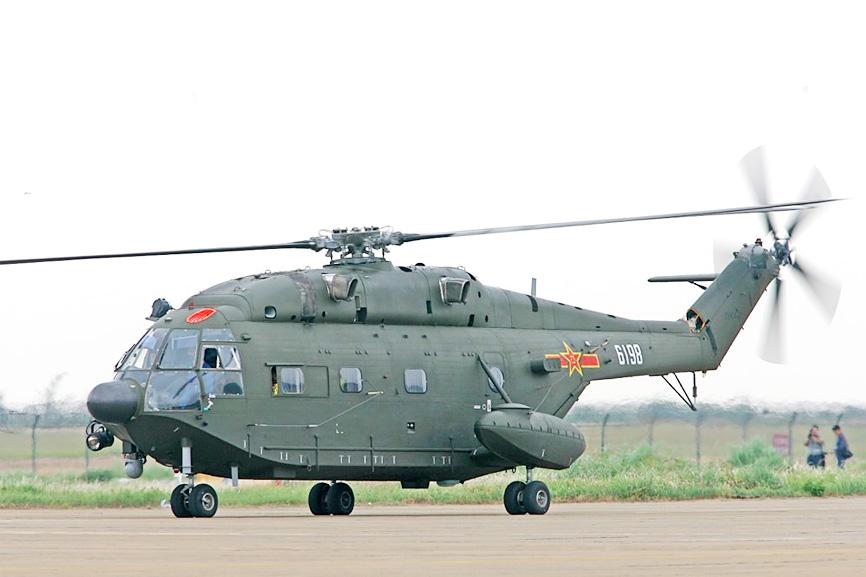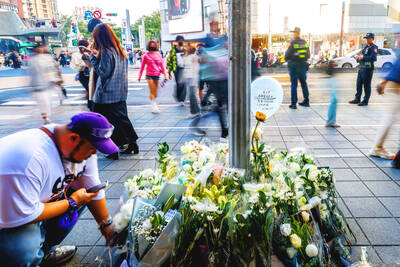The first-ever incursion of Chinese military helicopters into Taiwan’s southwestern air defense identification zone (ADIZ) this week suggests that the Chinese People’s Liberation Army (PLA) could be rotating through its arsenal of aircraft to probe the capabilities of the Taiwanese defense system and how it responds, experts said on Friday.
The Ministry of National Defense said that two Z-8 helicopters — the Chinese version of the French Aerospatiale SA 321 Super Frelon — and one Shaanxi Y-8 transport plane flew into the southwest ADIZ on Friday morning.
The ministry on Thursday said that a Harbin Z-9 “Haitun” helicopter and a Y-8 transport plane also flew into the ADIZ south of the Taiwan Strait, adding that it was the first recorded incident of Chinese helicopters since the ministry began reporting Chinese aerial incursions in September last year.

Photo courtesy of the Ministry of National Defense
Lu Li-shih (呂禮詩), a former instructor at the China Naval Academy in Kaohsiung, said that the Z-8 and Z-9 helicopters vary in their features, but have similar their radar cross-sections.
These are the two main types of helicopters that Taiwan’s military would most likely come across, Lu said.
By deploying one of the helicopter versions and observing how Taiwan reacts, Beijing can gather intelligence on Taiwan’s response procedures and how well the military knows Chinese helicopter types, he said.
Institute for National Defense and Security Research analyst Shu Hsiao-huang (舒孝煌) said the Z-8 is one of the mid-sized to large helicopters fielded by the PLA and has anti-submarine, airborne early warning and troop transport capabilities.
Any form of surprise landing in Taiwan would likely employ a Z-8, Shu said, adding that these helicopters can take off from large ships or newly created airfields along China’s southeastern coast.
Lu said that China could deploy more helicopter types to test Taiwan’s responses and to fatigue military pilots, adding that Beijing could also begin sending drones.
The military should deliver a complete countermeasure against Chinese harassment, Lu said.

SHIPS, TRAINS AND AUTOMOBILES: The ministry has announced changes to varied transportation industries taking effect soon, with a number of effects for passengers Beginning next month, the post office is canceling signature upon delivery and written inquiry services for international registered small packets in accordance with the new policy of the Universal Postal Union, the Ministry of Transportation and Communications said yesterday. The new policy does not apply to packets that are to be delivered to China, the ministry said. Senders of international registered small packets would receive a NT$10 rebate on postage if the packets are sent from Jan. 1 to March 31, it added. The ministry said that three other policies are also scheduled to take effect next month. International cruise ship operators

HORROR STORIES: One victim recounted not realizing they had been stabbed and seeing people bleeding, while another recalled breaking down in tears after fleeing A man on Friday died after he tried to fight the knife-wielding suspect who went on a stabbing spree near two of Taipei’s busiest metro stations, Taipei Mayor Chiang Wan-an (蔣萬安) said. The 57-year-old man, identified by his family name, Yu (余), encountered the suspect at Exit M7 of Taipei Main Station and immediately tried to stop him, but was fatally wounded and later died, Chiang said, calling the incident “heartbreaking.” Yu’s family would receive at least NT$5 million (US$158,584) in compensation through the Taipei Rapid Transit Corp’s (TRTC) insurance coverage, he said after convening an emergency security response meeting yesterday morning. National

PLANNED: The suspect visited the crime scene before the killings, seeking information on how to access the roof, and had extensively researched a 2014 stabbing incident The suspect in a stabbing attack that killed three people and injured 11 in Taipei on Friday had planned the assault and set fires at other locations earlier in the day, law enforcement officials said yesterday. National Police Agency (NPA) Director-General Chang Jung-hsin (張榮興) said the suspect, a 27-year-old man named Chang Wen (張文), began the attacks at 3:40pm, first setting off smoke bombs on a road, damaging cars and motorbikes. Earlier, Chang Wen set fire to a rental room where he was staying on Gongyuan Road in Zhongzheng District (中正), Chang Jung-hsin said. The suspect later threw smoke grenades near two exits

The Forestry and Nature Conservation Agency yesterday launched a gift box to market honey “certified by a Formosan black bear” in appreciation of a beekeeper’s amicable interaction with a honey-thieving bear. Beekeeper Chih Ming-chen (池明鎮) in January inspected his bee farm in Hualien County’s Jhuosi Township (卓溪) and found that more than 20 beehives had been destroyed and many hives were eaten, with bear droppings and paw prints near the destroyed hives, the agency said. Chih returned to the farm to move the remaining beehives away that evening when he encountered a Formosan black bear only 20m away, the agency said. The bear